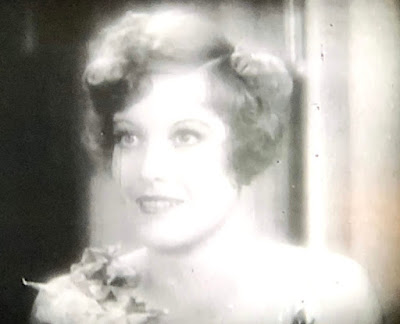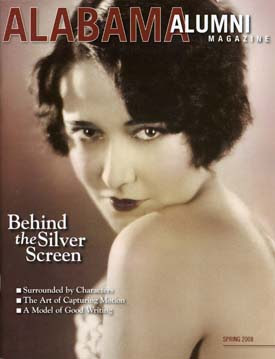Tuesday, July 21, 2020
Movies with Alabama Connections: Our Dancing Daughters
Sunday, July 19, 2020
Alabama History & Culture News: July 19 edition
| Huntsville leader's book details brushes with history and death Grainger and other Alabama editors were invited to the White House for a luncheon to discuss solving racial problems in the South. Four days later the ... |
John Lewis, civil rights icon and congressman, dies at 80 21, 1940, outside the town of Troy, in Pike County, Alabama. ... avid reader, and could cite obscure historical dates and details even in his later years. |
| Themed Trails Launched to Highlight Flavors of the Black Belt Press Release: Alabama Black Belt Adventures Association ... cultural attractions and historical sites that make the Black Belt region of Alabama a truly ... |
| Unearthing history: Old pottery kiln discovered on Limestone County farm Landowner Tommy Mitchell, right, and Joey Brackner, a folklorist for the Alabama State Council on the Arts, discuss the history of the kiln. Bracker, who ... |
| SPIRIT OF ALABAMA: MAN SHARES HIS LOVE OF TRACTORS WITH PASSERS-BY So most people who were raised on farms have a healthy appreciation for the history of tractors. Well, Sorrell Fleming got hooked on tractor collecting, ... |
| State: Clotilda preservation work to advance in October The Alabama Historical Commission announced Thursday that with $1 million in funding from the state, it will begin to move forward soon with the ... |
| State of Alabama commits $1 million to Clotilda preservation MONTGOMERY, Ala. (WKRG) — The state of Alabama appropriated $1 million to the Alabama Historical Commission to preserve the Clotilda, the last ... |
| Àbáké: America's Last Slave Ship Survivor Denied by the System and Betrayed by History Àbáké (meaning “born to be loved by all”) was only two years old when she arrived in Alabama in 1860. Her facial tribal marks—which are preserved ... |
| Birmingham's 16th Street Baptist Church exhibits tell story of hurting, healing 1 draw for visitors to Alabama right now and our tourism ministry, as we refer to it, helps us share our role and our history. “This is good because when ... |
Wednesday, July 15, 2020
Whatever Happened to Actress Gail Strickland?
A tall, athletic kid, Strickland wore a size-12 dress at age 12. “I played football with my brothers,” she says, then refines the memory: “Often, I was the football.” That posed a problem as she entered her teens. “When boys started looking differently at girls,” she says, “I wasn’t one of the ones they looked differently at.” Struggling for attention, she wrote plays and performed them in front of friends. At Florida State University, she made her mark as a gymnast and clown. “I didn’t know what Broadway was,” she says, “but I knew it was my goal.”
She reached it in 1973, in Status Quo Vadis, which had a short run. Such films as The Drowning Pool, Norma Rae and Protocol followed, along with countless TV guest shots. Still, says Strickland, “before Heartbeat, had you ever heard of me? That’s frustrating.”
In the article Strickland mentions a long-distance relationship with Neil Baker, a marketing consultant from Boston and their plans to marry in December 1988. I have been unable to find further information about that event.
According to the IMDB, Strickland's final credit was the 2008 film My Apocalypse. Her only other credits after 1999 were thirteen episodes of the series First Monday in 2002 in which she played a conservative justice on the U.S. Supreme Court.
Monday, July 13, 2020
Alabama History & Culture News: July 13 edition
| Despite strong community effort in Newcomerstown, Alabama town picked for HGTV makeover HGTV said Wetumpmka “has fostered something of a green revival, with newly christened walking and nature trails, and a nearby historic botanical area, ... |
| 'To Kill a Mockingbird,' published 60 years ago, still resonates The book is loosely based on Lee's observations of her family, her neighbors and an event that occurred near her hometown of Monroeville, Alabama, ... |
'The Wonder Years' Reboot to Center Around Black Family in Alabama The show offered a nostalgic look back at one of the most tumultuous times in recent American history, following young Kevin as he navigated junior ... |
| Wiregrass boxing trainer/promoter Johnny Trawick to be inducted in Alabama Boxing Hall of Fame Johnny Trawick has had a long history in the sport of boxing in the Wiregrass. Based out of Dothan and Ozark, Trawick has trained more than 3,000 ... |
| A Black Alabama hero fights for America and freedom in new novel “The Moon Above” is fiction, but it is historical fiction and, if anyone had a reason to hate von Braun at the time of his greatest triumph, it's a Black World ... |
| The Witches Reboot: What Anne Hathaway's Grand High Witch REALLY Means Zemeckis's film is set in Alabama during the 1960s, which holds a lot of weight in historical significance. Before and during the 1960s, Jim Crow laws ... |
| Local historians looking for Revolutionary War soldier's resting place in Marshall Co. According to records, he was originally buried at Rogers Cemetery, but his body ... Cargill moved to north Alabama in 1828 and passed away in 1847. |
| Las Cruces author pens definitive Pat Garrett history tells the historic and tragic history of Patrick Floyd Jarvis Garrett, who was born June 5, 1850 in Chambers County, Alabama. ... Garrett was killed, and you can find his grave in the Masonic Cemetery on Brown Road in Las Cruces. |
| “Fancy Strut: A Novel” By: Lee Smith There have been a great many bicentennial books discussing Alabama's founders, early history, larger cities and regions, and major twentieth-century ... |
| Bullock County citizens can contribute to Alabama's history By Faye Gaston. The Alabama Department of Archives and History (ADAH) is asking Alabama citizens to share their experiences during the crisis of ... |
| Anniston's 44-year-old Book Rack saved from closing by new owners Anniston's 44-year-old Book Rack saved from closing by new owners ... The Book Rack, an Anniston institution that was set to close after almost 45 ... the closure of all “nonessential” businesses in Alabama and across most of the ... |
| Letters to the Editor: If the Alabama Hills are renamed, what about the state of Alabama? This name is a stain on our history, and we can and must do better. It's been on my mind recently as an Angeleno after the powerful Black Lives Matter ... |
| 'I absolutely love big, beautiful Selma' “Selma is a special place in Alabama and the nation due to its history,” Smith said. “Selma provided Americans nationwide equal opportunities. Selma ... |
| The Lady from Dallas: Hattie Hooker Wilkins a forgotten champion of voting rights in Selma ... through historic Selma homes, was once the headquarters for Alabama's ... According to a 2016 article by the National Women's History Museum, .. |
| Black Lives Matter mural in Alabama has historical significance ... Michelle Browder believes art can change worldviews, so she designed and painted a Black Lives Matter mural in downtown Montgomery, Alabama ... |
| Historical record thin on specifics regarding Alabama's flag design ... state flag,” stated Steve Murray, Director of the Alabama Department of History and Archives. “We know that legislation was approved pretty quickly.”. |













































